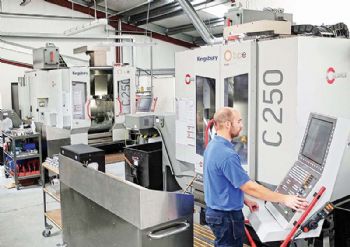
Craigavon-based sub-contractor Boyce Precision Engineering primarily serves the commercial aerospace sector, which accounts for 70% of its turnover.
Most of the company’s throughput involves producing aluminium parts for first-class and business-class seating, plus various aluminium structural components.
Its aerospace qualifications include AS9100 accreditation (the global quality management system for the aerospace industry) and the SC21 (Bronze Award) supply-chain recognition; it is also a member of the trade organisation ADS Group.
Boyce Precision was formed in 2006 and now has 34 staff. In recent years, there has been an increase in the complexity of the prismatic aerospace parts that the company manufactures, making a progression from three- to five-axis machining necessary.
For the new machining capacity, joint owners and brothers George and Brian Boyce decided to move away from the supplier of two thirds of their three-axis machines, opting instead for a Hermle C 250.
This German-built machine has a 600 x 550 x 450mm work envelope and was supplied in July 2017 by the Gosport-based sole UK and Ireland agent Kingsbury (
www.kingsburyuk.com). The capabilities of this machine were immediately apparent and a second identical model was |installed three months later.
The configuration of these Hermle vertical machining centres places the three linear axes within a modified gantry above the working area, while the integrated trunnion provides a rigid and stable platform for the two rotary axes, which include a ±115deg swivel that offers considerable production flexibility.
The machines at Craigavon have integral Blum tool-breakage detection to allow long periods of unattended running across the two shifts that Boyce Precision operates.
Increased complexity
A trend within the aircraft seating sector is the use of increasingly complex and larger components, so as to minimise the labour costs and delays associated with assembly.
Once orders for such parts were promised, Mr Boyce had no hesitation in placing an order for a larger Hermle C 400 with a working volume of 850 x 700 x 500mm.
It will be delivered in November 2018 to a new 18,000ft
2 factory unit currently being built for the sub-contractor in Portadown. This will treble the size of the company’s current premises; together with the third Hermle five-axis machine and the imminent purchase of two further three-axis machining centres, it represents an investment of some £3 million.
George Boyce said: “These are our first five-axis machines, so ordering the initial one was a big decision for us. Our company policy is to buy the very best equipment we can afford — not only machines but also work-holding, tooling and engineering software.
"While we had extensively researched the five-axis vertical machining-centre options, before going ahead with Hermle, I saw how the machines are made while attending at an Open House at the manufacturer’s factory in Gosheim, which gave me confidence in the build quality.
Moreover, the quality of the training we had meant that our engineers on the shopfloor were able to pick up five-axis operation quickly.”
The benefits of five-axis machining for Boyce Precision are significant, particularly as, for one third of the time, the two Hermle C 250s are running programs requiring interpolation of all five CNC axes simultaneously — work that
previously could not have been undertaken.
For contracts that require only three-axis cycles, automatic positioning and clamping of the rotary axes reduces the number of separate operations needed to complete a job; indeed, aerospace parts that used to require two or three separate operations are now completed in one hit.
Major savings
One pharmaceutical component that used to require eight separate set-ups now requires only two with five-axis working.
In fact, the pharmaceutical sector, together with medical contracts, accounts for 20% of Boyce Precision’s turnover, with the remaining 10% spread across the automotive industry, motor-sport, TT racing and general engineering.
The latter work focuses on contracts for the construction industry, particularly bespoke jigs and fixtures, but it also includes the manufacture of items for film sets — such as aluminium-bladed swords, daggers, shield parts and catapults used by actors in the television series Game of Thrones.
The reduction in the number of set-ups also means that tight tolerances can be held more easily. On some aerospace parts — and even those for the pharmaceutical industry (such as blister-pack tooling) — the accuracy required
is ±20µm.
Highlighting the construction and rigidity of Hermle machines, George Boyce recounts an incident in January this year, when the 18,000rev/min HSK 63 spindle of the second Hermle C 250 was accidentally knocked out of alignment by an operator.
Fortunately, the machine has a patented safety feature in the spindle where-by six mounting bolts with collapsible sleeves crumple and absorb the energy just long enough for the shock to be detected and automatic
machine stoppage triggered.
The spindle itself was undamaged and needed only to be remounted with six new bolts, which was done by one of Kingsbury’s local service engineers in a few hours the next working day.
This spindle arrangement saved the expense of buying a new spindle cartridge (and perhaps the motor), as well as the costs of more major maintenance and extended machine down-time; and to ensure that there was no underlying spindle damage, vibration analysis files captured at different rotational speeds were sent by Kingsbury engineers to the Hermle factory for evaluation.
It confirmed that the accident had not caused a spindle fault.